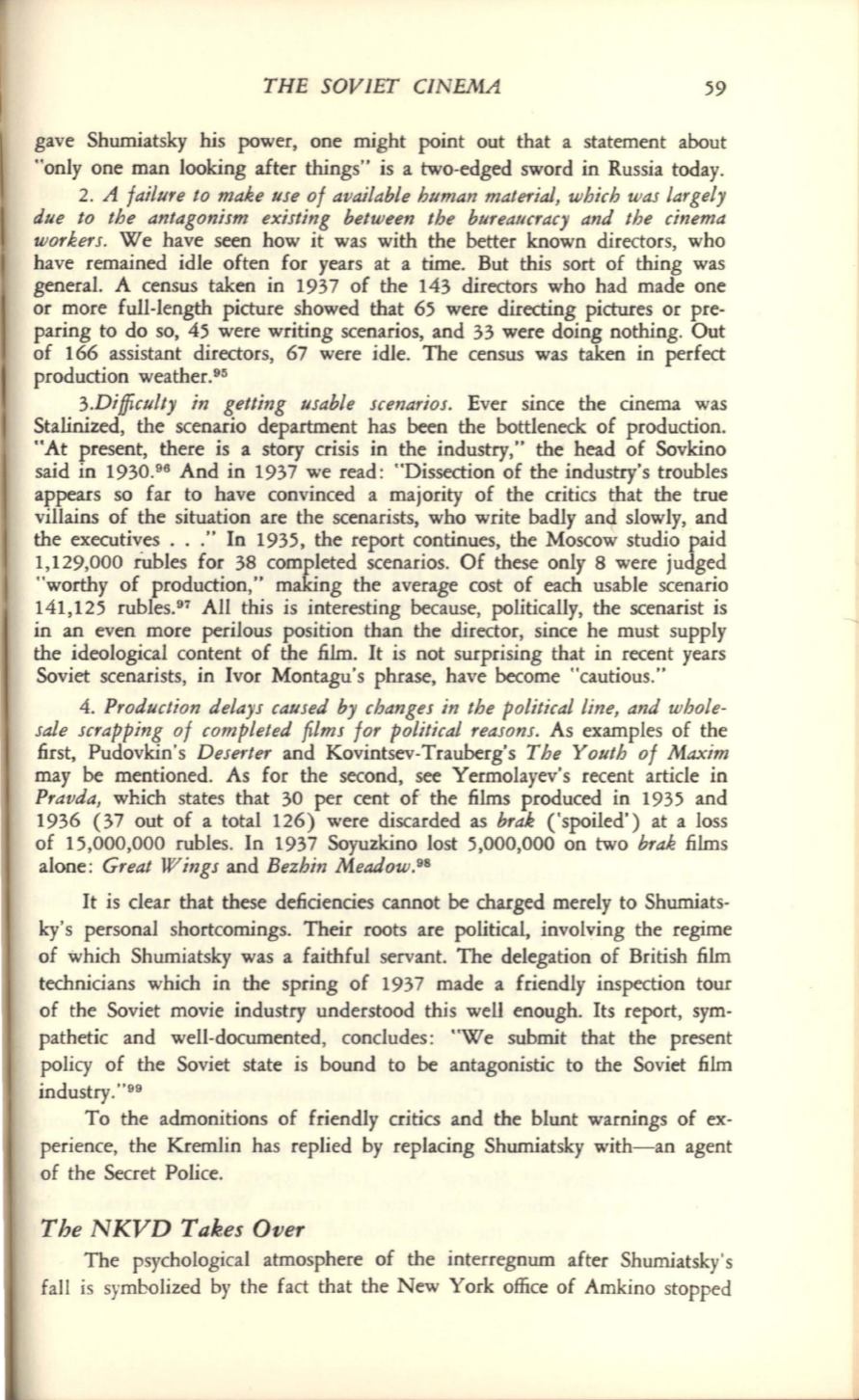
THE SOVIET CINEMA
59
gave Shumiatsky his power, one might point out that a statement about
"only one man looking after things" is a two-edged sword in Russia today.
2.
A failure to make use of available human material, which was largely
due to the antagonism existing between the bureaucracy and the cinema
workers.
We have seen how it was with the better known directors, who
have remained idle often for years at a time. But this sort of thing was
general. A census taken in
1937
of the
143
directors who had made one
or more full-length picture showed that
65
were directing pictures or pre–
paring to do so,
45
were writing scenarios, and
33
were doing nothing. Out
of
166
assistant directors,
67
were idle. The census was taken in perfect
production weather.95
3.Difficulty in getting usable scenarios.
Ever since the cinema was
Stalinized, the scenario department has been the bottleneck of production.
"At present, there is a story crisis in the industry," the head of Sovkino
said in
1930.
96 And in
1937
we read: "Dissection of the industry's troubles
appears so far to have convinced a majority of the critics that the true
villains of the situation are the scenarists, who write badly an4 slowly, and
the executives .. ." In
1935,
the report continues, the Moscow studio paid
1,129,000
r"ubles for
38
completed scenarios. Of these only
8
were judged
"worthy of production," making the average cost of each usable scenario
141,125
rubles. 97 All this is interesting because, politically, the scenarist is
in an even more perilous position than the director, since he must supply
the ideological content of tpe film. It is not surprising that in recent years
Soviet scenarists, in Ivor Montagu's phrase, have become "cautious."
4. Production delays caused by changes in the political line, and whole–
sale scrapping of completed films for political reasons.
As examples of the
first, Pudovkin's
Deserter
and Kovintsev-Trauberg's
The Youth of Maxim
may be mentioned. As for the second, see Yermolayev's recent article in
Pravda,
which states that
30
per cent of the films produced in
1935
and
1936 (37
out of a total
126)
were discarded as
brak
('spoiled') at a loss
of
15,000,000
rubles. In
1937
Soyuzkino lost
5,000,000
on two
brak
films
alone:
Great Wings
and
Bezhin Meadow.
9S
It is clear that these deficiencies cannot be charged merely to Shumiats–
ky's personal shortcomings. Their roots are political, involving the regime
of which Shumiatsky was a faithful servant. The delegation of British film
technicians which in the spring of
1937
made a friendly inspection tour
of the Soviet movie industry understood this well enough. Its report, sym–
pathetic and well-documented, concludes: "We submit that the present
policy of the Soviet state is bound to be antagonistic to the Soviet film
industry."99
To the admonitions of friendly critics and the blunt warnings of ex–
perience, the Kremlin has replied by replacing Shumiatsky with- an agent
of the Secret Police.
The NKVD Takes Over
The psychological atmosphere of the interregnum after Shumiatsky's
fall is symbolized by the fact that the New York office of Amkino stopped


